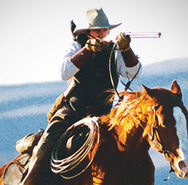Marlin Makes a Comeback

If there’s a gunmaker that’s suffered from more rumored deaths than Marlin, I wouldn’t be able to name it. Since being acquired by Remington in 2007, the iconic levergun manufacturer has been killed off by internet trolls and industry veterans (who should know better) more times than an extra in a George Romero zombie flick. Through it all, the company has kept making guns, although lower production levels and decreased line offerings have given some credence to Marlin’s rumored demise among outsiders who would rather hold on to nostalgia at the cost of lost business.
A lagging economy and a lack of capital investments over the years dealt Marlin a double blow in the late part of the last decade. But according to company officials, Remington has never had any plans to kill off the company. Instead, engineers and craftsmen have been working behind the scenes to drag Marlin into the 21st century while maintaining the legacy of quality and performance that Marlin enthusiasts hold dear. The process has not been easy, and Remington admits to missteps that have pushed back time lines and caused plenty of angst both within and beyond the company walls. “To say we made a couple of mistakes is a bit of an understatement,” says Teddy Novin, director of public affairs. “We opened the door for Rossi and Henry, but with our new production process for the receiver in a side-by side comparison, there is no comparison. We’re working hard to bring it back.”

Part of that hard work was recovering from a poorly planned move from Marlin’s longstanding manufacturing plant in North Haven, Connecticut, to Remington-operated factories in Ilion, New York, and Mayfield, Kentucky. The 2010 decision to close the North Haven plant, thus ending Marlin’s 140-year tradition of manufacturing in Connecticut, was not an easy one to swallow, both for those making the decision and the company’s fervent fan base. But for Marlin to continue as a viable brand, it was necessary.
“Marlin had great heritage and history in the North Haven community,” says John Fink, senior product manager for Remington. “They had a skilled and tenured workforce that knew how to build Marlin rifles. We were faced with some tough decisions to make that impacted those people and the local community.”
While the craftsmen at Marlin were first-rate, the manufacturing facilities in North Haven were less than great. Machines were held together with what amounted to little more than Band-Aids, creating inefficient and costly production processes.
“The biggest known issue was that Marlin was in need of capital investment,” says Fink. “We were dealing with equipment that was old—in some cases, more than 60 years old. Some of the equipment was in such bad shape that sheet-metal dams had been built around the machines to keep fluids from leaking out onto the floor.”
Just four hours away, in Ilion, Remington’s factory had some open floor space where it could move Marlin, keep it autonomous from Remington, and yet improve efficiency. “We realized it would be a challenging move,” says Fink. “It required moving equipment, setting it up in a new location, and training people to build these rifles.
Old equipment does not travel well. Once this equipment was moved to Ilion, many of the pieces were running at a rate that was even less efficient than before.”
Compounding the difficulties, Remington discovered dimensioned drawings of Marlin’s iconic rifles did not exist. The plans at North Haven had simply been passed down through the generations. Many of these workers hadn’t made the move to Ilion, so much of that inherent knowledge had been lost. “We were training a new workforce to build these rifles,” says Fink. “We have a great workforce in Ilion with gun making talent, but they had never built lever-action rifles before, so there was learning curve.”
Through it all, Remington remained committed to saving Marlin, though you can bet there were some difficult, and heated, discussions. Luckily, cooler heads and common sense prevailed, due in large part to the fact that no one at Remington wanted to be responsible for killing off a brand that so many of them loved. “The Marlin lever-action rifle is such a great rifle. It has killed so many deer, and given so many people their start in hunting and shooting, that there is no way we could ever quit making Marlin rifles,” says Fink. “We are putting the resources behind the rifles to ensure they will be available for generations.”
To save Marlin from imploding, Remington invested both dollars and manpower in a multifaceted approach to achieve the kind of quality that had slipped during the transition. From a manufacturing standpoint, the company has set up a stand-alone Marlin factory within the Ilion plant, with its own designated managers, workforce, and assemblers, people who are committed and invested in the Marlin brand.
On the product side, Marlin reduced its offerings from 29 catalog lever-gun models down to 18. They also eliminated any customer exclusive guns, at least temporarily. The SKU reduction allowed the factory to focus on the rifles they had a greater ability to produce on a consistent basis, which tended to be the highest-volume offerings. Plans call for rifles that were suspended to make their way back into the line as the manufacturing process works outs its kinks. “We hoped to do that in late 2012, however we were not as far along as we would have liked to have been,” says Fink. “This process was very painful for me, as it would be for anyone who is passionate about rifles.”
At the same time lines were being reduced, R&D engineers started a project to complete three-dimensional drawings of all the parts. Meanwhile, production engineers were evaluating what new modern equipment would be necessary once they knew the exact dimensions that would be coming off the machine.
“We have now completed these dimensional drawings for the 336 line and 1895 line, since they are the most similar,” says Fink. “This year, we will also be in the same position on the 1894 line. New equipment for these lines has been purchased and is operational. We have seen great improvement over the year, and we continue to focus on further improvements.” For 2014, Marlin is reintroducing four suspended offerings, including two .338 Marlin Express rifles, the 1895 Cowboy, and the .444 Marlin. The company is also introducing a Limited Edition series, with the first rifle being a 336 Limited featuring a high-grade walnut stock, high-polish blued metal with some light scroll engraving, and the Marlin horse and rider in 24-carat gold on the left receiver panel. Future plans call for a new introduction to the series each year, with changes in engraving patterns, model, and overall configuration.
“When we suspended the items we did in mid-2011, there were a total of five new offerings we had engineering looking at for production,” says Fink. “There is a lot of opportunity for completely new offerings and exciting rifles that we can bring back.”
With these new introductions and continuing roll-outs of previously canceled production lines, Marlin looks to be on solid footing. But will it be enough to finally put an end to the ongoing rumors of the company’s imminent death, which still crop up on shooting and hunting forums? Only time will tell. But to those doubters, company officials want to impress the commitment they have to the brand.
Maybe a word from on high sums it up best. “Marlin is back,” says Novin. “We owe it to the brand to do it justice.”
[Reprinted from the June/July 2014 National Shooting Sports Foundation SHOT Business newsletter.]
